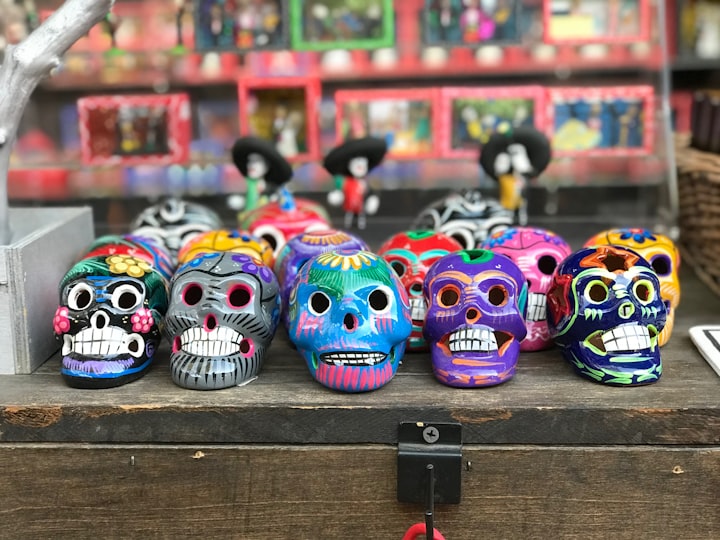Magically Real Situations in Fantasy Novels
A study of Magical Realism in Cemetery Boys
Magical realism is a longstanding tradition in Latinx writing and oral storytelling and is often confused with the fantasy genre, but it should be recognized as its literary technique. Magical realism influences modern fantasy in the young adult novel Cemetery Boys by Aiden Thomas by providing the young adult audience with a familiar world but tackling taboo topics in a magical way that offers more room to explore without the restrictions of the real world.
According to the Oxford English Dictionary, magical realism is a relatively newer term, first coined by Franz Roh in 1925. The first version of the word exists as a subtitle, “magischer Realismus,” in the German book Nach-Expressionismus. The term originated to describe a literary and art movement called Neue Sachlichkeit. The Oxford English Dictionary defines magical realism as “any artistic or esp. literary style in which realistic techniques such as naturalistic detail, narrative, etc., are similarly combined with surreal or dreamlike elements.” In the 1990s, South American magical realism was explored and attributed to writers such as Gabriel Garcia Marquez.
Magical realism is not the same as fantasy. According to The Routledge Companion to Latino/a Literature, magical realism is “a form of narrative fiction writing whereby the narrative makes no distinction nor discriminates between events that defy the laws of nature (in physics or genetics, for example) and those that conform to the laws of nature” (Aldama 334). A narrative that does not discriminate from what the reader would see as obviously non-conforming to the reality of the world, and treats these occurrences in the story as everyday normalcy, gives readers a word that is familiar and unfamiliar at the same time, giving readers more room to explore the themes being discussed in the story without it being too real to handle. Magical realism effectively creates worlds in which adolescent readers can explore the natural world with magical elements, acting as a transition into the adult world. In the student article “Carpe Librum: Seize the (YA) Book: Possible Impossibilities: The Power of Magical Realism for Adolescent Readers,” published by the National Council of Teachers of English, Tricia Ebarvia asserts, “Adolescence is a time for testing and teasing boundaries of what is real and possible. The beauty of magical realism is that it's exactly these possibilities that are interrogated” (62). As young adults are in the difficult phase between adulthood and childhood, magical realism will create a world between the magic of childhood and the real adult world.
Don Latham remarks in his article “The Cultural Work of Magical Realism in Three Young Adult Novels” that magical realism was once only associated with literature from Latin America but has moved to be included in works not only around the world and from multiple cultural backgrounds but also has become relevant in young adult literature. Don Latham includes research from other authors Lois Parkinson Zamora and Wendy B. Faris, “magical realism transgresses boundaries; it concerns itself with ‘liminal territory ... phenomenal and spiritual regions where transformation, metamorphosis, dissolution are common’’’ (Latham 59). He explains that this liminality included in magical realism speaks to adolescents' liminal state between childhood and adulthood. Relating to Aldama, spaces that defy the laws of nature provide comfort at a time when young adults defy nature's laws.
While magical realism in young adult literature provides safety and exploration to all young adults, it is significant for young adults that may not often see a representation of their ethnic or cultural background. Latham writes, “magical realism is often associated with the perspectives of certain national and ethnic groups that were at one time colonized and/or otherwise disenfranchised, such as Latin Americans, Indians, Africans, African Americans, and Native Americans” (Latham 61) because of the subversive and transgressive nature of magical realism that speaks to people who have experienced discrimination and disempowerment according to his research on another author by the name of Bowers. The reality of marginalized communities is one of oppression, not of magic.
Latham introduces the novel Baby Be-Bop, “set in the realistic and yet not quite real world of Los Angeles, a kind of ‘liminal territory'” (Latham 62) that is somewhat reminiscent of the setting of the novel Cemetery Boys. Magical realism is being used to talk about the taboo in young adult literature that prevails in the book series that Baby Be-Bop comes from. Dirk, a character mentioned earlier, struggled with his sexuality. Latham explains, “these visitations may be hallucinations does not invalidate their reality for Dirk; in fact, their indeterminacy further illustrates the ‘‘near-merging’’ of realms that Faris identifies as a characteristic of magical realism” (Latham 64).
Finally, Vandana solidifies this point in the conclusion of the article “ Magical Worlds, Real Encounters: Race and Magical Realism in Young Adult Fiction,” in which she discusses magical realism in more young adult literature. She concludes her article with, “Adolescents, the “others” existing within our own cultural boundaries, discover affinities with racial others and their alternative world views; as the protagonists from these two novels recognize the shortcomings of the culture they come from, they discover another set of cultural and social practices that had hitherto been misunderstood and maligned” (Vandana 50). While all young adults benefit from magical realism, marginalized communities most relate to it. This is evident in the novel Cemetery Boys by Aiden Thomas.
Cemetery Boys is listed under the fantasy genre as a novel. However, like most works written for and by marginalized writers or audiences, it is being forced into the boxes of the preconceived standards for specific genres created in canon by non-marginalized communities. Yadriel himself is being forced into standards that do not fit him. Yadriel is transgender, but his family refuses to let him participate in their magical traditions at the beginning of the book because of his identity. Yadriel’s world is between the world that an audience would recognize as “the real world” and a magical one. His world is secret to people outside of his community.
Still, the magical realism in the novel needs to be acknowledged as an addition and influence from the Latinx traditions that Thomas is passing down to a younger generation. The novel's main character, Yadriel, exists in multiple liminal spaces that translate to being in a magically real world. The character is transgender, placing him within this liminal space between his true identity and the person his family sees him as and expects him to be. Yadriel can also see the dead as a brujx whose purpose is to help restless souls to the afterlife. His abilities put him in a space between life and death that also aligns with the Latinx holiday of Dia de Los Muertos, in which it is believed that ancestors come back to visit with their families and be remembered on certain days.
Yadriel’s struggle is not solely his own. His cousin also struggles with not fitting into their traditions because of her veganism. They band together. As the story goes on and Yadriel feels alone in being transgender within his community, a ghost tells him, “There’s no way y’all have been around for thousands of years without there being one person not fitting into the ‘men are this, women are that’ bullshit” (Thomas 183-184). The world that the audience is in is so binary and opposing that even though the characters are actively moving between the worlds of life and death, being transgender would still be an issue within the community being presented. Vandana presents in her article, “The collective narratives– magical ones that come from the oral and folk traditions and ‘real’ ones that come from the social, legal, and political systems– both form an integral and crucial part of the magical realism in adolescent fiction” (Vandana 45). Providing young adults, especially those who have grown up in similar traditions, can see themselves more with the characters because of their proximity to their reality.
This magic within proximity to their reality gives young adults a chance to recognize and adapt to any taboo topics they might be experiencing. In Cemetery Boys, Yadriel knows he is a boy whether his family agrees. The addition of validation from Lady Death solidifies his identity to his family and that he is a Brujo. Yadriel’s father, who held him back for most of the novel, says, “Lady Death would not bind you to a dagger- your dagger,’ he emphasized,’ if you weren’t a brujo, Yadriel” (Thomas 240). Yadriel now had recognition from his family on top of the magical Lady Death. This emphasizes Yadriel’s identity, as there is no reasoning or defying a magical entity that has already been established as the final word. Latham says in his article, “magic serves not only as a catalyst for identity transformation but also as a means for questioning the established social order” (Latham 67).
Finally, magical realism is more inclusive than fantasy. Fantasy creates a new world rather than working with an already-made one. The world that young adults live in is already filled with problems that need to be faced. Yadriel faces discrimination. Julian faces stereotypes and a lack of stability, which must be reflected and dealt with. Aldama ends his article on Magical realism, “In this last instance, it offers Latino authors a powerfully expansive and radically inclusive storytelling mode for them to develop their creativity” (Aldama 341). The inclusivity of standard demographics and issues within the novel creates a world where Latinx adolescents, who have often been cast aside, get put to the forefront and can magically assess their issues.
Using magical realism in Cemetery Boys creates a world in which young adults can explore and grapple with their harsh realities in a way that encourages them to think outside the box and still magically experience the world through their transition from childhood. The novel speaks specifically to the transgender and Latinx experience that traditions can smother or embrace in the real world. Magical realism in the novel allows its young adult readers to reflect on their identities in very real ways while still holding onto their childhood. Magical realism also passes down important literary traditions to modern novels, keeping familiarity and pride within the Latinx community in new ways.
Works Cited
Aldama, Frederick. “Magical Realism.” The Routledge Companion to Latino/a Literature, edited
by Suzanne Bost and Frances Aparicio, Taylor and Francis Group, 2012, pp. 334–41. ebookcentral.proquest.com/lib/fullerton/detail.action?docID=1039357&pq-origsite=prim o#.
Latham, Don. “The Cultural Work of Magical Realism in Three Young Adult Novels.”
Children’s Literature in Education, vol. 38, no. 1, Springer Science and Business Media LLC, June 2006, pp. 59–70. https://doi.org/10.1007/s10583-006-9017-1.
Schmidt, Pauline Skowron, and Tricia Ebarvia. “Carpe Librum: Seize the (YA) Book: Possible
Impossibilities: The Power of Magical Realism for Adolescent Readers.” The English Journal, vol. 106, no. 1, Sept. 2012, pp. 62–65. JSTOR, www-jstor-org.lib-proxy.fullerton.edu/stable/26359323?sid=primo#metadata_info_tab_c ontents.
Saxena, Vandana. “Magical Worlds, Real Encounters: Race and Magical Realism in Young Adult
Fiction.” The ALAN Review, vol. 38, no. 3, 2011,https://doi.org/10.21061/alan.v38i3.a.6.
Thomas, A. (2021). Cemetery Boys. Swoon Reads.
About the Creator
Miss Ghoul
Credentialed English teacher







Comments
There are no comments for this story
Be the first to respond and start the conversation.